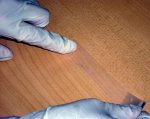

Testing for mold can be useful after a house has been used for illegal marijuana grow ops. Most people wonder whether testing for mold could help determine whether a home was ever used for marijuana grow ops. The simple answer is no because the limiting factor to mold growth in houses is moisture regardless of the source of moisture. Houses used for grow ops usually have excessive moisture which make them prone to mold growth. Some molds found in houses used for grow ops such as some species of Stachybotrys, Aspergillus and Penicillium are associated with adverse health effects. Others like Alternaria and Cladosporium are well known allergens that trigger allergic reactions in sensitized individuals.
Although, not all molds that occur in indoor environment (including grow operation houses) are hazardous, one cannot take the risk of living in a moldy home. Current Canadian mold guidelines advise building occupants to clean-up and/or remove visible mold growth. The key to control mold growth is to reduce or eliminated moisture.
Testing for mold is recommended if buying a home (especially an old home) because there is always a risk of buying one with mold. Some molds are indicators of moisture damage and their presence could be an indication of moisture problems in the home. If you see mold growth, you may send tape samples to the lab to determine whether the mold present is hazardous or is only of cosmetic concern. Cleaning hazardous mold requires special protection. If a house is known to have been used for marijuana marihuana) grow ops and there is no visible mold growth, air testing for mold would be recommended. Air testing for mold may reveal hidden mold growth. To take a sample of visible mold growth, you can order for a professionally made tape slide (see the tape slide below) or in an emergency situation, use clear scotch tape.
Testing for Mold Using Clear Scotch Tape
You can sample visible mold using a commercial sticky slide or using Clear Scotch Tape

How To Take Mold Samples Using Clear Scotch Tape
- Cut approximately 5 cm (2”) of clear Scotch tape (not opaque or duct tape). Hold it along the edges, trying not to touch the sticky side.
- Press the tape gently onto the surface to be sampled.
- Peel the tape off the surface, holding it by the edges as much as possible and place it sticky side down on a piece of wax or grease paper.
- Place the paper in a clean zip lock plastic bag.
How To Take Mold Samples Using Commercial Tape Slide
- Wear suitable gloves. If you are likely to disturb the mold, you should also wear a mask.
- Record the sample number on the slide label.
For example:- Sample #1 or Tape #1.
- Peel off seal from slide to expose adhesive (see the words “Peel Here”)
- Place sticky side of slide onto the surface with visible mold growth and press gently.
- Place slide back into plastic snap-case.
- Repeat the same procedure for any other sample you wish to take.
- Once you have taken all the samples, complete the Mold Analysis Request Form.Provide information on where the samples were collected, for example:
- Tape #1: Basement, east wall
- Tape #2: Windowsill, master bedroom
- Tape #3: Ceiling tile, bathroom
- Tape #4: Under counter, kitchen sink.
- Enclose samples in an envelope for sending by post or courier.
(NOTE: More than one mold type may be present. If several sites show visible mold growth, it is advisable to take more than one sample.)
Sending Samples for Mold Testing
Submit the samples together with the following information:
- Name
- Address
- Phone
- Fax (if available)
- Email address
- The date the sample was collected
Call 905-290-9101 for pricing. You may pay by credit card (Visa or MasterCard) or by cheque. Mail or deliver samples to:
1020 Brevik Place, Unit 1A
Mississauga, ON L4W 4N7
Canada

Latest posts by Jackson Kung'u (see all)
- Symptoms of mold exposure - September 4, 2015
- Mildew and Moisture in Homes - September 3, 2015
- Mould Removal - September 2, 2015
